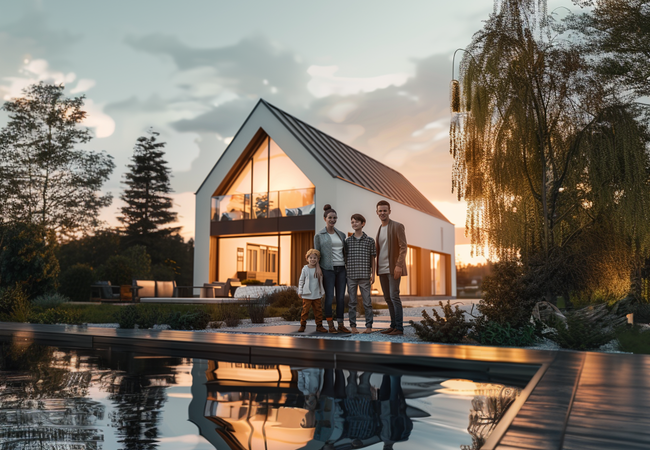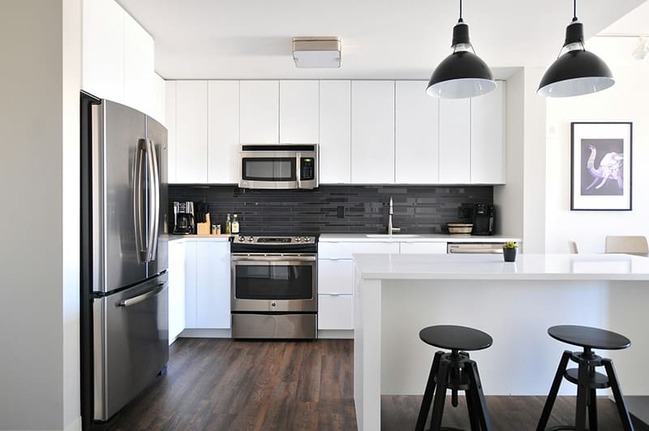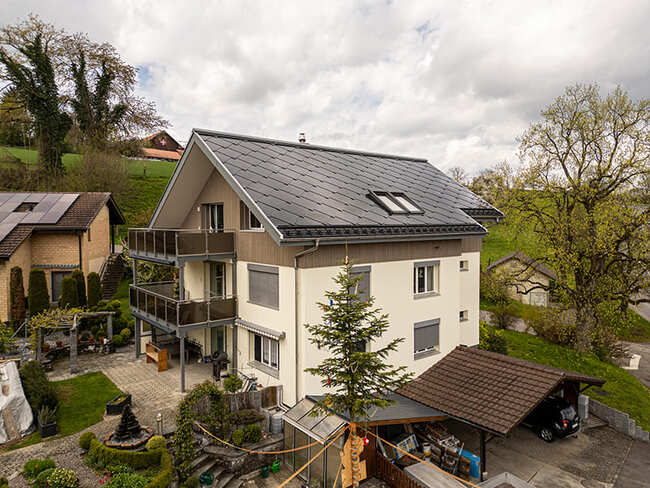The installation of solar panels on the roof of one’s own home is gaining popularity when it comes to reducing one’s personal carbon footprint.Thanks to advances in solar technology and the steadily declining costs of solar panels, it’s easier than ever to produce solar energy for household use. In this blog article, we explain the roof area needed to cover the energy needs of a family of four in Central Europe with sustainable electricity. We also highlight why a simple indication of surface area is not always the right approach.
Fundamentals for a solar installation

When delving into the world of solar energy, it’s helpful to understand the fundamental factors that influence the efficiency of electricity production from a solar installation.
Roof type and age:
The type and age of the roof are crucial for choosing the appropriate solar solution. Flat roofs require different systems than older sloped roofs that are soon to be renovated.
Orientation and tilt:
The orientation and tilt of solar panels play a crucial role in energy yield. Panels facing south with an angle of 30 to 45 degrees are optimal.
Geographical location:
The intensity of sunlight hitting your solar installation depends on the geographical location. In Central Europe, solar irradiation varies depending on location and season. Being closer to the equator means more sunlight and thus increased installation efficiency.
Power and size of modules: The efficiency of solar modules on your roof directly influences the amount of energy produced. High-efficiency modules produce more electricity than lower-efficiency ones. However, it’s also important to consider how many square meters of solar modules can be placed on your roof. Conventional solar modules (standard size approximately 1700x1100mm) are generally large and rectangular. If the shape of a sloped roof is not also rectangular or if the roof surface has obstacles such as skylights or chimneys, the solar installation quickly becomes a patchwork, which also affects performance and overall appearance. In this area, smaller integrated roof solar modules (BIPV) offer a clear advantage, as even in complex roof shapes, they allow for full utilization of available space.
You can find more information on these aspects in our article:
When does a solar system make sense?
For an existing building, not all of these factors can be influenced. However, for a new construction, roof quality, orientation, and tilt of the roof surface must be carefully planned in order to fully utilize solar energy.
Average electricity consumption of a household

Household appliances such as refrigerators or ovens have high energy consumption. (Image: Unsplash.com)
To determine the need for solar panels to power a four-person family’s home in Europe, it’s important to consider the average electricity consumption of a European household. The average electricity consumption in Europe is around 4,000 kWh per year. However, with the use of a heat pump, this value doubles. The efficiency of solar panels currently ranges from 150 to 200 watts peak per square meter (Wp/m²). For our calculations, we will therefore use an average value of 175 Wp/m².
Simplified Example Calculation for a House in Europe
Note: This example calculation is highly simplified, as in reality, many factors influence effective electricity generation and consumption.
Consumption of a 4-person household: 4000 kWh per year (without a heat pump)
Solar panel power: approximately 175 Wp/m²
Calculation: 4000/175 = 22.8
Minimum required area: approximately 23 m²
In this scenario, a roof area of 6×4 meters would already be sufficient to meet the basic needs of a four-person family.
However, it is important to note that an average calculation of electricity consumption is not always precise. Individual characteristics of the household, such as aging power-hungry appliances, can significantly increase consumption. Likewise, the condition of the building plays a role, with older buildings with poor insulation typically requiring more energy than modern buildings with energy-efficient construction, as is often aimed for with the Minergie standard. Nowadays, since the old oil tank is often replaced with a more sustainable heat pump, this higher electricity consumption automatically affects the area calculation.
Example with Heat Pump
Consumption of a 4-person household: 8000 kWh per year (with heat pump)
Solar panel power: approximately 175 Wp/m²
Calculation: 8000/175 = 45.7
Minimum required area: approximately 46 m²
In this scenario, the required roof area doubles accordingly.
Therefore, the recommended area for solar panels is typically set higher than the minimum value to adequately account for these factors.
Determining adequate Solar Panel coverage

Depending on the season, the sun delivers more or less energy. (Image: Unsplash.com)
When choosing the appropriate area for your solar installation, there are several aspects to consider that go beyond the actual efficiency of the system and average electricity consumption itself.
Seasons
The planning of your solar installation should take into account the short days in winter. This is because one of the contradictory facts of solar energy lies here: While during the summer, when maximum electricity production typically occurs, less energy is usually needed for heating and hot water, energy demand increases significantly in the winter months. Ideally, the solar installation should be able to cover your family’s basic needs even during the months with low sun exposure. The larger the system, the more likely this is to be the case.
Self-consumption Rate
If your solar installation generates more energy than you consume, you can usually sell the surplus to your energy provider. However, due to the continuous decline in feed-in tariffs in recent years, it is advisable to maximize self-consumption as much as possible. Further information on self-consumption can be found here.
Administrative Costs
The installation of a solar system entails various costs. Regardless of the size of the system – whether it’s a mini solar system or an extensive installation – certain costs remain constant. Depending on the country and municipality, a building permit may be required for the installation. The costs for the necessary scaffolding are similar regardless of the size of the system. Likewise, the effort for the electrical infrastructure, such as wiring on the roof, cable routing into the house, and installation of inverters, does not vary significantly between a system of 30 m² or 80 m².
Subsidies
Subsidies can significantly influence the profitability of your solar installation. The availability and amount of subsidies vary depending on the location and can make opting for a larger system financially more attractive.
Aesthetics
The harmonious integration of the solar installation into the building structure is not only of subjective importance but should be considered in the planning process. While conventional rooftop systems can affect the appearance of a building and disrupt the local landscape, modern in-roof systems are optimally integrated into the building envelope and enhance the architectural aesthetics of the building. An in-roof solar system automatically contributes to an increase in the value of the property.
The optimal size of your solar installation depends on a number of factors. In addition to current conditions, future developments should also be considered, as requirements and funding opportunities may change.
Future Influencing Factors

A high-quality roof-integrated solar system increases the resale value of a building.
The impact of climate change and other global changes on our lifestyle is difficult to predict. However, there are certain megatrends that should already influence your decision regarding the size of a solar installation.
Electric Vehicles
The development and proliferation of electric vehicles (EVs) are expected to continue in the coming years. In 2023, nearly one-fifth of all newly registered vehicles in Germany were electric*. If you plan to use one or more electric cars, the personal demand for solar power increases significantly. This should be considered when calculating the required solar area on your roof.
*Source: https://www.adac.de/news/neuzulassungen-kba/
Storage
Parallel to the rise of electromobility, energy storage technologies have also undergone significant advancements. Modern storage solutions are not only more powerful but have also become more affordable due to advancements in production technology. The ability to store energy locally offers numerous benefits: from bridging periods of bad weather to charging your electric vehicle at night. Solar installations combined with a battery storage system increase self-consumption and independence from the grid. Moreover, many storage systems are modularly expandable to meet growing needs.
More about E-Mobility
Heating System
The choice of heating system can also play a role, especially if you are considering installing an electrically powered heat pump. Such systems can double a household’s energy demand, but when combined with a solar installation, they offer the opportunity to maximize energy consumption.
Resale Value
Investing in a solar installation can significantly increase the value of your property. In a time where awareness of sustainability and energy efficiency is increasing, such features appear particularly attractive to future buyers. The ability to reduce energy costs while making a positive contribution to environmental protection significantly contributes to increasing the resale value of your property. Especially when the solar installation is harmoniously integrated into the roof structure and visually appealing, this can further enhance the value of your building.
Conclusion
Given the multitude of current and future influencing factors, the question is no longer just about the required square meters of solar panels. Rather, one should consider which solution best fits their situation and how the existing roof area can be optimally utilized to generate as much energy as possible.
The decision to install a solar system is an important step towards sustainability and independence from fossil fuel sources. For a four-person family in Europe with average electricity consumption, a carefully planned solar installation is not only ecologically sensible but can also be financially attractive. Taking into account various factors such as roof condition, geographical location, and individual energy needs, the optimal size of the solar installation may vary. Future technological developments and personal preferences, such as transitioning to electric vehicles or installing an energy storage system, also play an important role in planning.
Do you have further questions about the right size of your solar roof or do you need assistance with a project? Then contact us, we are happy to provide you with personalized advice.
For more information about SunStyle’s solar roof, visit sunstyle.com
Power your interest in the future of solar roofing by following us:
Instagram @sunstyle_solar
Facebook @sunstylesolar
LinkedIn linkedin.com/company/sunstylesolar
Youtube @youtube channel


